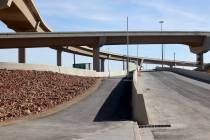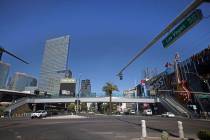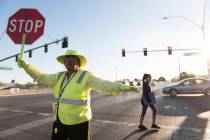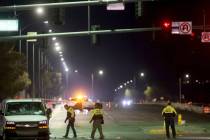Think of dirt piles as work in progress
Now you see them, now you don't. That's a common theme around the Las Vegas Valley when it comes to construction workers and even construction sites. Sometimes people see projects start and then abruptly stop, even when it appears as though the work isn't near completion. That has Ken curious.
Here's Ken: There used to be a lot of activity at the west end of Cactus Avenue at the railroad tracks. A large mound of dirt was built up on both sides, and then the work just completely stopped. What gives? The Desert Oasis High School kids need a way to cross the tracks to get to school, but nothing is happening.
Also, just to the north of this dirt bridge, a large berm was built up for about a quarter mile. This berm runs parallel to the railroad tracks and extends the length of Torrey Pines Road and Pyle Avenue. What the heck is this large built-up mound for?
There are a few things going on in that area, Ken. First off, the county is building the Duck Creek Railroad Detention Basin, so that explains the flurry of activity you saw recently. The dirt removed for the basin was piled up and will be used for the ramps on the future Cactus Avenue overpass that will cross Interstate 15. Rather than hauling off the dirt, storing it somewhere else and bringing it back, Clark County officials decided it would be less expensive and more efficient to leave it on site. Construction of that overpass, by the way, is scheduled to start early next year. There are other piles of dirt that will not be used for the ramps but simply haven't been taken away just yet.
Aquilino likes the final countdown: I was wondering what you think of "the countdown to yellow light" that I see in various corners signifying how many seconds there are left before the traffic light turns yellow. I find it very useful in planning what I need to do as I approach crossing an intersection. It is my opinion that it prevents accidents, since there is no need to guess when the green light will turn yellow, hence no need to take a chance in speeding up and/or suddenly braking. I wonder if it is an experiment and I wonder what the results are? Does the county plan on installing more of these instead of the "gotcha" cameras?
Those timers are part of the flashing yellow arrow system that has been installed at a handful of Las Vegas Valley intersections. As I mentioned a couple of weeks ago, the flashing yellow arrows are replacing the solid green light and allows motorists to make a left turn while merging to oncoming traffic. You might see the countdown boxes without the flashing arrow, but the arrow is likely not far behind.
As far as safety, studies have proved that the flashing arrow is safer because it catches motorists' attention. As far as the countdown, that is unknown. The feature is used by drivers but designed to help pedestrians. This is not a pilot program. In fact, the city of Las Vegas recently installed the system at two intersections and plans to add another 300 in the future.
An additional note: Cameras you see atop traffic signals are to monitor traffic and time signals. In Nevada, it is illegal to use these cameras as a law enforcement tool.
Sheila questions paratransit: I was waiting for the paratransit bus for 25 minutes inside my apartment complex. In the meantime five other buses came into the complex and each picked up one person. Why doesn't one vehicle pick up everybody instead of making someone wait 25 minutes?
This undoubtedly appears to be an inefficient way to operate the paratransit system, which for those of you who don't know is a transportation service for disabled residents. What Sheila witnessed is probably rare, but it can happen and doesn't necessarily mean the system is inefficient. Paratransit dispatchers use software that tells them how best to assign vehicles based on rides. If, for example, Sheila lives in the northwest, it wouldn't make sense to have one vehicle pick up all the passengers if each were headed to a different part of the valley. Also, if subscription passengers, or those who have scheduled weekly appointments for treatments such as dialysis, are headed to the same location, the same vehicle might pick them up even if their homes are not near each other.
Keeping with paratransit, here's Ed: I heard the Regional Transportation Commission was going to eliminate monthly passes for paratransit. Don't they realize some of us can't afford individual rides. Some of us have multiple doctor's appointments in a single week and couldn't afford paratransit without monthly passes.
Ed, yes, that was discussed. The paratransit service is costing the money-strapped Regional Transportation Commission more and more every year. The agency was hit particularly hard when the state stopped subsidizing shuttles to community and senior centers last year. A handful of passengers abuse the service and don't plan their trips in an efficient manner, which puts more demand on paratransit. That said, administrators at the agency are no longer considering eliminating the monthly pass at this point. "We heard loud and clear from the community that this would create a hardship," RTC spokeswoman Tracy Bower said. The agency is taking a look at other ways it can reduce the cost to run the service. I'll keep you posted if something changes.
Contact reporter Adrienne Packer at apacker@reviewjournal.com or 702-387-2904.
• Expect delays on Interstate 15 between Tropicana Avenue and the Spaghetti Bowl as crews prep for a repaving project. Preparation work will last until Friday.
• Starting Sunday and lasting six weeks, repaving work on Interstate 15 will cause around-the-clock lane closures between Tropicana and the Spaghetti Bowl.
• Starting today and continuing for two months, lane restrictions will be in effect 24 hours a day on Rainbow Boulevard. Rainbow will be reduced to one lane between Gowan Road and Red Coach Avenue while crews repave the street. Alternate routes include Tenaya Way and Rancho Drive.
• From 9 p.m. Thursday to 5 a.m. Friday, the ramp from I-15 south to Interstate 215 west will be closed for sign and aesthetic panel installation.
• For the next three weeks, the left lane of I-15 south will be closed between Russell Road and Sunset Road. Lanes will shift to the right. The third lane from the left might continue southbound or exit onto the Las Vegas Beltway east. The fourth lane from the left can access only the Beltway east or west. The configuration will be in place 24 hours a day to accommodate work on express lanes.
• For the next six months, the ramp from south Las Vegas Boulevard to northbound Interstate 15 will be closed 24 hours a day. Traffic will be detoured. Also, westbound Las Vegas Beltway traffic headed to northbound I-15 will be diverted to a temporary ramp about 1,500 feet west of the current ramp. The closures are to allow crews to work on bridges and walls in the area.
TRIATHLON ALERT: Delays are expected Sunday morning because of the Marine Corps Ironman World Championship 70.3 triathlon. The race starts at Lake Las Vegas, loops into the Lake Mead National Recreation Area and finishes at the Henderson Pavilion. Road closures and detours will be in effect from 6:30 a.m. till 6 p.m. A complete list of closures is available at hendersonlive.com/special-events/ironman.
GASOLINE PRICES
The average price of gasoline in the Las Vegas Valley on Tuesday was $3.62 per gallon; the current state average is $3.67; the national average is $3.66. Find the Las Vegas Valley's best deals at gasbuddy.com.
LAS VEGAS REVIEW-JOURNAL























